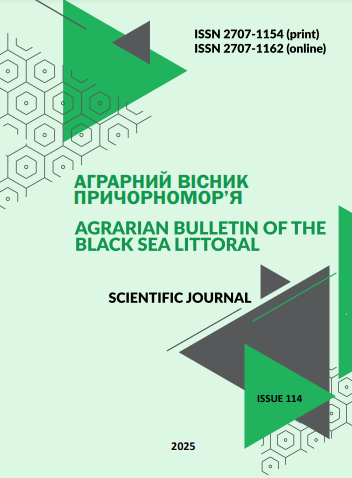IMMUNOGRAMA INDICATORS IN TOXOPLASMOSIS-SEROPOSITIVE AND SERONEGATIVE CATS WITH ATOPIC DERMATITIS
DOI:
https://doi.org/10.37000/abbsl.2025.114.01Keywords:
Atopic skin syndrome in cats, FASS, Toxoplasma gondii, infectious agents, immunograms, autoimmune diseases.Abstract
Scientific studies indicate the absence of a single diagnostic test that could reliably diagnose atopy in cats. The question of infectious agents as factors in the occurrence and exacerbation of atopic dermatitis is debatable in the scientific literature. One of such pathogens is Toxoplasma gondii. The study aimed to determine the differences in immunogram parameters between seropositive and seronegative to toxoplasmosis cats with atopic dermatitis, which will provide an opportunity to adjust therapeutic approaches when conducting treatment protocols. The study involved cats (n=14) with a diagnosis of "atopic dermatitis". Stabilized blood was used for the study. It was collected from the subcutaneous vein of the forearm. After laboratory tests of blood parameters, the cats were divided into two groups, depending on the presence of anti-toxoplasmosis antibody titers in the blood serum. Analysis of the obtained data showed that in the group of seropositive to toxoplasmosis cats with atopic dermatitis, the absolute number of leukocytes was significantly (p<0.05) higher by 2.89 G/l (30%). The assessment of the absolute number of the population of granular leukocytes showed that in the first group the number of monocytes was significantly (p<0.05) twice as high and the number of neutrophils – by 27% (p<0.05). The higher number of neutrophils in the first group of cats was also reflected in the ability of these cells to phagocytosis, which was also higher by 31%. The absolute number of lymphocytes was also 27% higher in the first group (p<0.05). The population of T-lymphocytes had a smaller difference in absolute number between the groups compared to granulocytes. At the same time, the difference in the number between the groups of T-lymphocyte subpopulations was not the same. There was practically no difference between the absolute number of natural killer lymphocytes, which belong to innate cellular immunity. When assessing the degree of lymphocyte sensitization to neuroantigen and adrenaline, a higher sensitization to neuroantigen was found in the group of cats that were seropositive for toxoplasmosis. Therefore, antigenic irritation by Toxoplasma of the body of cats with atopic dermatitis is accompanied by an increase in the population of immunocompetent cells and their activity.
References
Aboukamar, W. A., Habib, S., Tharwat, S., Nassar, M. K., Elzoheiry, M. A., Atef, R., & Elmehankar, M. S. (2023). Association between toxoplasmosis and autoimmune rheumatic diseases in Egyptian patients. Reumatologia clinica, 19(9), 488–494. https://doi.org/10.1016/j.reumae.2023.03.006
Anfray, P., Bonetti, C., Fabbrini, F., Magnino, S., Mancianti, F., & Abramo, F. (2005). Feline cutaneous toxoplasmosis: a case report. Veterinary dermatology, 16(2), 131–136. https://doi.org/10.1111/j.1365-3164.2005.00434.x
Bajwa J. Atopic dermatitis in cats. Can Vet J. 2018. 59, 3. 311-313. URL: https://pmc.ncbi.nlm.nih.gov/articles/PMC5819051/ (дата звернення 02.04.2025)
Donato, G., Pennisi, M. G., Persichetti, M. F., Archer, J., & Masucci, M. (2023). A Retrospective Comparative Evaluation of Selected Blood Cell Ratios, Acute Phase Proteins, and Leukocyte Changes Suggestive of Inflammation in Cats. Animals : an open access journal from MDPI, 13(16), 2579. https://doi.org/10.3390/ani13162579
Dubey J. P. (1998). Advances in the life cycle of Toxoplasma gondii. International journal for parasitology, 28(7), 1019–1024. https://doi.org/10.1016/s0020-7519(98)00023-x
Dubey J.P., Lindsay D.S., Lappin M.R. Toxoplasmosis and other intestinal coccidial infections in cats and dogs. Vet Clin North Am Small Anim Pract. 2009. 39,
1009-v. doi: 10.1016/j.cvsm.2009.08.001
Elmore S.A. et al. Toxoplasma gondii: epidemiology, feline clinical aspects, and prevention. Trends Parasitol. 2010. 26, 4. 190-196. doi:10.1016/j.pt.2010.01.009
Forte, W. C., Guardian, V. C., Mantovani, P. A., Dionigi, P. C., & Menezes, M. C. (2009). Evaluation of phagocytes in atopic dermatitis. Allergologia et immunopathologia, 37(6), 302–308. https://doi.org/10.1016/j.aller.2009.06.003
Halliwell R. et al. Immunopathogenesis of the feline atopic syndrome. Vet Dermatol. 2021.32, 1. 13-e4. doi:10.1111/vde.12928
Heidel J.R. et al. Myelitis in a cat infected with Toxoplasma gondii and feline immunodeficiency virus. J Am Vet Med Assoc. 1990. 196, 2. 316-318. URL: https://pubmed.ncbi.nlm.nih.gov/2153650/ (дата звернення 01.04.2025)
Hoffmann A.R. et al. toxoplasmosis in two dogs. J Vet Diagn Invest. 2012. 24, 3. 636-640. doi:10.1177/1040638712440995
Lappin M. R. (2010). Update on the diagnosis and management of Toxoplasma gondii infection in cats. Topics in companion animal medicine, 25(3), 136–141. https://doi.org/10.1053/j.tcam.2010.07.002
Moore A. et al. Fatal disseminated toxoplasmosis in a feline immunodeficiency virus-positive cat receiving oclacitinib for feline atopic skin syndrome. Vet Dermatol. 2022. 33, 5. 435-439. doi:10.1111/vde.13097
Mueller R.S. et al. Treatment of the feline atopic syndrome - a systematic review. Vet Dermatol. 2021. 32, 1. 43-e8. doi:10.1111/vde.12933
Oliveira V.D.C. et al. Occurrence of Leishmania infantum in the central nervous system of naturally infected dogs: Parasite load, viability, co-infections and histological alterations PLoS One. 2017. 12, 4. e0175588. doi: 10.1371/journal.pone.0175588
Pena H.F. et al. Isolation and biological and molecular characterization of Toxoplasma gondii from canine cutaneous toxoplasmosis in Brazil. J Clin Microbiol. 2014. 52, 12. 4419-4420. doi:10.1128/JCM.02001-14
Ravens P.A., Xu B.J., Vogelnest L.J. Feline atopic dermatitis: a retrospective study of 45 cases (2001-2012). Vet Dermatol. 2014. 25, 2. 95-e28. doi:10.1111/vde.12109
Roosje, P. J., Thepen, T., Rutten, V. P., van den Brom, W. E., Bruijnzeel-Koomen, C. A., & Willemse, T. (2004). Immunophenotyping of the cutaneous cellular infiltrate after atopy patch testing in cats with atopic dermatitis. Veterinary immunology and immunopathology, 101(3-4), 143–151. https://doi.org/10.1016/j.vetimm.2004.03.010
Roosje, P. J., Whitaker-Menezes, D., Goldschmidt, M. H., Moore, P. F., Willemse, T., & Murphy, G. F. (1997). Feline atopic dermatitis. A model for Langerhans cell participation in disease pathogenesis. The American journal of pathology, 151(4), 927–932.
Sana, M., Rashid, M., Rashid, I., Akbar, H., Gomez-Marin, J. E., & Dimier-Poisson, I. (2022). Immune response against toxoplasmosis-some recent updates RH: Toxoplasma gondii immune response. International journal of immunopathology and pharmacology, 36, 3946320221078436. https://doi.org/10.1177/03946320221078436
Sanchez, S. G., & Besteiro, S. (2021). The pathogenicity and virulence of Toxoplasma gondii. Virulence, 12(1), 3095–3114.
https://doi.org/10.1080/21505594.2021.2012346
Santoro D. et al. Clinical signs and diagnosis of feline atopic syndrome: detailed guidelines for a correct diagnosis. Vet Dermatol. 2021. 32, 1. 26-e6. doi:10.1111/vde.12935
Downloads
Published
How to Cite
Issue
Section
License

This work is licensed under a Creative Commons Attribution-NonCommercial 4.0 International License.


